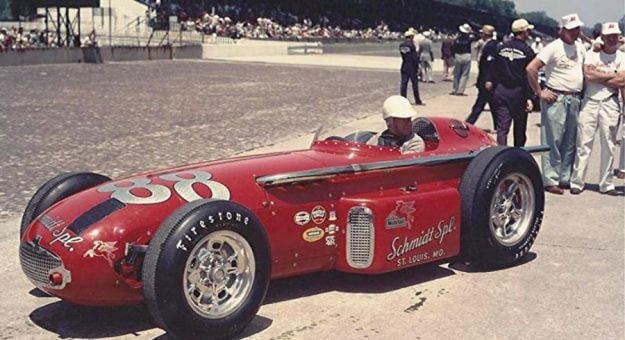The adage “still water runs deep” personifies the original “Flying Scott,” Johnny Thomson.
Nondescript, private, practically unnoticed in the pits, he seemed as tranquil as a moonlit lake. But once on the track, the fire within roared white-hot and that tranquility evaporated as he focused on his primary goal — winning — with an intensity that could cut steel.
And he won repeatedly.
During his tragically brief career on the highly competitive national championship trail, Thomson competed in only 69 races. He won seven of those while registering 43 top-10 finishes. His accomplishments on the short tracks earned him spots in both the National Sprint Car Hall of Fame and the National Midget Racing Hall of Fame.
The first of his national championship wins came at The Milwaukee Mile. Yet, one of his most significant champ car victories happened June 1, 1957, on the deadly dirt of Langhorne (Pa.) Speedway.
Driving the D-A Lubricants Kuzma, Thomson grabbed the pole and mounted a sustained charge toward history. Running high and hard, he lapped the entire field by the 41st lap.
Suddenly, the right-rear tire blew, forcing him to make a pit stop, usually a death knell in a 100-mile race. He roared back on the track in third, however, and mounted a relentless run toward first place. He made it and took the checkered flag in just under an hour, the first time a 100-mile dirt-track race was completed at an average speed above 100 mph.
Like many of his era, Thomson began his career in midgets. He built his own car when he was 17 and raced it at a track across the street from his Lowell, Mass., home.
When World War II interrupted his budding racing career, Thomson joined the Army Air Corp. and served as a B25 bomber crew chief. He received five Battle Stars and the Distinguished Air Force Medal because of his actions in the skies over Italy and Corsica.
After the hostilities ended, he rejoined the midget wars, racking up 32 wins and the UCOA midget championship in 1948. He captured the title again in 1950. His success attracted the attention of the AAA car owners and Thomson smoothly made the transition to the elite organization.
In 1952, he won the AAA Eastern Midget Series championship and added AAA sprint cars to his already impressive résumé. In 1954, he won the AAA Eastern Sprint Car Series title.
His performance on the short tracks earned him a ride at Indianapolis.
The magnitude of a race driver’s talent is often confirmed at Indianapolis Motor Speedway. Thomson demonstrated he belonged. He won Indy’s prestigious pole and twice came close to winning the 500.
In 1953, his rookie year, he squeezed an obsolete sled into the field in last place but fell out early. For ’54 he qualified the famed “Basement Betsy” fourth quick and again broke early in the race.
In 1955, he came into his own. Qualifying one of only nine upright dirt cars in the field, Thomson started last and raced to second against a host of new Indy roadsters.
Over the next three years, Thomson ranked among the fastest qualifiers and grabbed the pole in 1959 driving the bright pink, Lujie Lesovsky-built Racing Associates Special. He led 40 laps and was running quicker than leaders Rodger Ward and Jim Rathmann before a torsion bar failed. He finished third.
Back in the Racing Associates car in 1960, he led 10 laps and remained in contention until a slow pit stop, with only 25 laps remaining, put him 37 seconds behind Rathmann and Ward, who were fiercely fighting for victory.
Outrunning the speeding duo by as much as 1.8 seconds per lap, Thomson quickly cut that to 11 seconds, then to seven. But on lap 190 a piston burned and Thomson finished fifth.
After two spectacular 500s, many believed a victory was in his future.
That wasn’t to be.
On Sept. 24, 1960, during a USAC sprint car race in Allentown, Pa., his car flipped through the fence in a thrashing, devastating crash. Thomson died a few hours later.
